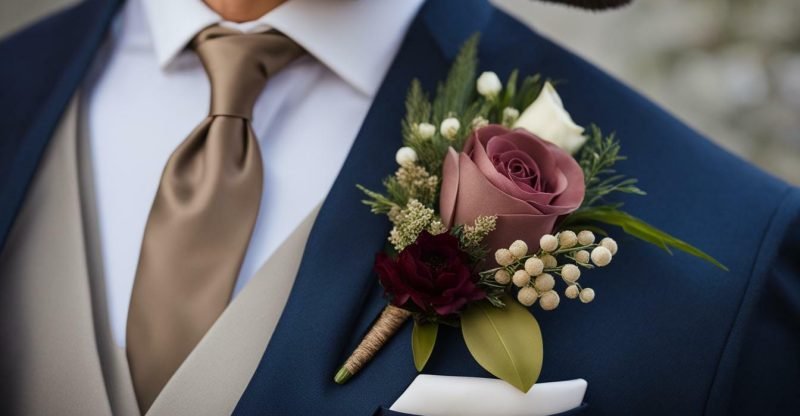The Essentials of Boutonniere Etiquette for Your Wedding Day
When it comes to your wedding day, mastering the rules of boutonniere etiquette is essential for creating a polished and cohesive look. A boutonniere is a single flower or small cluster of flowers worn on the left lapel of a suit or tuxedo jacket. It adds a touch of elegance to the groom and other key members of the wedding party.
Key Takeaways:
- Understanding what a boutonniere is and its significance in weddings
- Knowing who should wear a boutonniere, including the groom, groomsmen, fathers, grandfathers, ring bearers, ushers, officiant, and other VIPs
- Choosing the right flowers for boutonnieres, such as orchids, roses, ranunculus, or succulents
- Considering cost considerations and who typically pays for boutonnieres
- Coordinating corsages with boutonnieres, especially for female guests
What is a Boutonniere?
A boutonniere is a stylish flower accessory that adds a touch of charm to the attire of the groom and other important members of the wedding party. It is a small floral arrangement typically worn on the left lapel of a suit or tuxedo jacket. The boutonniere serves as a delightful accent to the groom’s ensemble, allowing him to showcase his personal style and complement the overall wedding theme.
Traditionally, boutonnieres consist of a single flower or a small cluster of flowers. Popular choices include roses, orchids, ranunculus, and succulents. These flowers are known for their durability and can hold their shape without water, making them ideal for long-lasting wear throughout the wedding day.
When selecting a boutonniere, it’s important to consider the color and style of the groom’s attire, as well as the overall color scheme of the wedding. The boutonniere should harmonize with the rest of the floral arrangements and complement the bride’s bouquet. It’s also a good idea to have backup boutonnieres on hand, just in case of any mishaps or wilting.
| Boutonniere Tips: |
|---|
| Choose flowers that can hold their shape without water. |
| Consider the color and style of the groom’s attire. |
| Ensure the boutonniere complements the bride’s bouquet and overall wedding theme. |
| Have backup boutonnieres in case of wilting or damage. |
Adding Elegance to the Wedding Party
“A boutonniere is not just a flower accessory; it is a symbol of elegance and attention to detail. By wearing a boutonniere, the groom and his entourage can elevate their overall appearance and create a cohesive look that ties together the entire wedding party. It’s a small but significant touch that adds a touch of charm and sophistication to the occasion.”
When it comes to boutonniere etiquette, it’s essential to understand the significance of this floral accessory and how it contributes to the overall aesthetic of the wedding. By following the proper guidelines and considering the preferences of each individual, you can ensure that the boutonnieres complement the attire and add an extra touch of elegance to your special day.
| In Summary: |
|---|
| A boutonniere is a stylish flower accessory worn on the left lapel of a suit or tuxedo jacket. |
| Popular choices for boutonnieres include roses, orchids, ranunculus, and succulents. |
| Consider the groom’s attire, the overall wedding theme, and have backup boutonnieres available. |
| Boutonnieres add an elegant and charming touch to the wedding party. |
Who Should Wear a Boutonniere?
Boutonnieres are not limited to just the groom; there are several key members of the wedding party who should wear these stylish floral accessories. Traditionally, boutonnieres are worn by the groom, groomsmen, fathers, grandfathers, ring bearers, ushers, and the officiant. These individuals play important roles in the wedding ceremony, and the boutonniere adds a touch of elegance to their attire.
However, it is also common for other VIPs, such as close family members and friends, to wear boutonnieres. Including them not only honors their special connection to the couple but also creates a cohesive look for the entire wedding party. The size and style of the boutonniere may vary, but it is important to ensure that everyone who is wearing one is treated equally and feels included in this special tradition.
When deciding who should wear boutonnieres, it is essential to consider the overall aesthetic of the wedding. The boutonnieres should complement the bridal bouquet and other floral arrangements. It is best to consult with your florist or wedding planner to ensure that the boutonnieres align with the theme, color palette, and style of the wedding. By taking these factors into account, you can create a cohesive and visually appealing look for your wedding day.
| Traditional Boutonniere Wearers | Additional Boutonniere Wearers |
|---|---|
| Groom | Close family members |
| Groomsmen | Close friends |
| Father of the bride | Ring bearers |
| Father of the groom | Ushers |
| Grandfathers | Officiant |
Remember, the boutonniere is a beautiful and meaningful accessory that adds a special touch to your wedding day. By including the key members of your wedding party and considering the overall aesthetic, you can create a cohesive and stylish look that will make your special day even more memorable.
Choosing the Right Flowers for Boutonnieres
Choosing the right flowers is crucial for creating stunning boutonnieres that will stay fresh and vibrant throughout the wedding day. When selecting flowers for boutonnieres, it is important to consider the following factors:
- Longevity: Opt for flowers that can hold their shape without water, as boutonnieres will be worn for several hours. Popular choices include orchids, roses, ranunculus, and succulents.
- Color and Style: Coordinate the color of the boutonniere flowers with the wedding color scheme and theme. Consider the style of the wedding, whether it is formal, rustic, or modern, and choose flowers that complement the overall aesthetic.
- Backup Options: It is always a good idea to have backup boutonnieres in case of wilting or damage. Prepare extra flowers or even consider opting for silk or fabric boutonnieres that will maintain their appearance throughout the day.
Remember, the boutonnieres should complement the attire of the wearer and enhance their overall look. Consider the color and style of the suits or tuxedos as well as any other accessories, such as ties or pocket squares.
Boutonniere Flower Options
While there are endless possibilities when it comes to boutonniere flowers, here are some popular choices:
| Flower | Meaning |
|---|---|
| Roses | Symbolize love and passion |
| Orchids | Represent luxury and elegance |
| Calla Lilies | Symbolize beauty and sophistication |
| Ranunculus | Signify charm and radiance |
| Succulents | Portray strength and resilience |
These flower options offer a variety of colors, shapes, and meanings to suit different wedding styles and personal preferences. Choose the flowers that align with the overall vision for the wedding and reflect the personalities of the couple.
Who Pays for the Boutonnieres?
Understanding who is responsible for paying for the boutonnieres ensures that everyone is on the same page when it comes to wedding expenses. Traditionally, the groom takes care of the cost of the men’s boutonnieres. This includes the boutonnieres for himself, the groomsmen, fathers, grandfathers, ring bearers, ushers, and the officiant. It’s a traditional gesture that showcases the groom’s appreciation for their involvement in the wedding.
However, it’s important to note that wedding etiquette has evolved, and there can be variations in who takes on this responsibility. If the bride’s family is covering the overall flower expenses, including the bouquets, centerpieces, and other floral arrangements, they may also include the cost of the boutonnieres in their budget. In some cases, the couple may decide to split the cost or cover it jointly.
Ultimately, it’s essential to have an open and clear communication with all parties involved to establish who will be responsible for paying for the boutonnieres. This will help avoid any misunderstandings or disagreements as the wedding planning progresses.
Corsage and Boutonniere Etiquette
Corsages and boutonnieres are traditional floral accessories that complement each other and add a touch of elegance to any wedding celebration. A corsage is a small bouquet typically worn by female guests, while a boutonniere is a single flower or small cluster of flowers worn by male guests. Understanding the etiquette surrounding these accessories is important to ensure that they are appropriately chosen and worn on your special day.
Coordinating Corsages and Boutonnieres
When selecting corsages and boutonnieres, it is essential to coordinate their styles and colors with the overall wedding theme and attire. The corsage should complement the dress or outfit of the recipient, featuring flowers that align with the wedding’s color scheme. For boutonnieres, the key is to choose flowers that match the bridal bouquet while incorporating the theme and style of the wedding. It is recommended to consult with a florist to ensure a cohesive and visually stunning floral ensemble.
“Corsages and boutonnieres are traditional floral accessories that complement each other and add a touch of elegance to any wedding celebration.”
Pinning and Placement
Pinning corsages and boutonnieres correctly is crucial to ensure they stay in place throughout the event. For corsages, they are typically pinned to the left side of the bodice of a dress or can be worn on the wrist with a ribbon. It is important to secure them firmly but not too tightly to avoid discomfort. Boutonnieres, on the other hand, are traditionally pinned to the left lapel of a suit or tuxedo jacket. They should be placed slightly angled and positioned just above the heart. It is advisable to use a sturdy pin or corsage magnet to prevent any mishaps during the festivities.
Who Should Receive Corsages and Boutonnieres?
While the groom, groomsmen, fathers, and grandfathers are commonly seen wearing boutonnieres, corsages are traditionally given to mothers, grandmothers, bridesmaids, and other significant female guests. However, the decision of who should receive these floral accessories ultimately rests with the couple. It is essential to consider cultural and family traditions, as well as individual preferences when determining who will wear corsages and boutonnieres.
| Corsage Recipients | Boutonniere Wearers |
|---|---|
| Mothers | Groom |
| Grandmothers | Groomsmen |
| Bridesmaids | Fathers |
| Other important female guests | Grandfathers |
By following the proper corsage and boutonniere etiquette, you can ensure that these floral accessories enhance the beauty and elegance of your wedding day. Remember to consider personal preferences, coordinate with the wedding theme, and secure them carefully for a picture-perfect look.
Proper Placement of Boutonnieres
Properly pinning a boutonniere is crucial to ensure it stays in place and adds a stylish finishing touch to the wedding attire. Follow these simple steps to achieve the perfect placement:
- Start by positioning the boutonniere on the left lapel of the suit or tuxedo jacket. The stem should be angled slightly towards the shoulder.
- Secure the boutonniere in place by carefully inserting a pin through the fabric of the lapel, going from the inside out. Be sure to catch the stem of the boutonniere without piercing through the front of the lapel.
- Gently push the pin back through the lapel fabric, making sure it is hidden from view. This will create a secure hold for the boutonniere.
- Finally, adjust the boutonniere as needed, ensuring it sits upright and is centered on the lapel.
Remember, practice makes perfect. If you’re unsure about pinning a boutonniere, don’t hesitate to seek assistance from a professional florist or someone experienced in wedding preparations. With a little practice and attention to detail, you’ll master the art of boutonniere placement for a refined and sophisticated look on your wedding day.
| Benefits of Proper Boutonniere Placement |
|---|
| “Proper placement ensures the boutonniere stays secure throughout the day, eliminating the need for constant adjustments.” |
| “A well-positioned boutonniere adds a touch of elegance and sophistication to the groom and wedding party’s attire.” |
| “A properly pinned boutonniere creates a cohesive look, harmonizing with the overall wedding theme and style.” |
Wedding Flower Etiquette
Understanding and following proper wedding flower etiquette ensures that your floral arrangements are thoughtfully chosen and enhance the overall ambiance of your special day. From boutonnieres to corsages, each floral accessory plays a significant role in adding beauty and elegance to your wedding.
When selecting flowers for boutonnieres, it is important to choose blooms that can withstand the day without wilting or losing their shape. Popular choices include orchids, roses, ranunculus, and succulents. Remember to have backup boutonnieres on hand in case of any last-minute mishaps.
The responsibility of paying for boutonnieres traditionally falls on the groom. However, if the bride’s family is covering the cost of the flowers, they may also include the boutonnieres in their floral arrangements. It is always best to discuss and clarify this aspect with all parties involved to avoid any confusion.
Pro Tip: To ensure that the boutonnieres are secure throughout the day, use floral pins or magnets to attach them to the lapel. This prevents any accidental damage or movement, allowing the boutonnieres to stay in place and look their best.
When it comes to corsages, they are typically worn by female guests and can be an alternative or addition to boutonnieres. Corsages are traditionally pinned to the bodice of a dress or worn on the wrist with a ribbon. They are often given to mothers, grandmothers, bridesmaids, and other important female guests as a token of honor and appreciation.
| Flowers for Boutonnieres: | Cost Considerations: |
|---|---|
| When budgeting for boutonnieres, consider the number of guests who will be wearing them, the types of flowers chosen, and any additional decorations or embellishments. It is important to ensure that the cost aligns with your overall wedding budget and personal preferences. |
Keeping these wedding flower traditions in mind and following proper etiquette will help create a cohesive and visually appealing atmosphere on your special day. Whether it’s the groom’s boutonniere or the corsages worn by important female guests, each floral accessory adds a touch of elegance and charm to the overall wedding celebration.
Types of Flowers for Boutonnieres
With a wide variety of flowers to choose from, selecting the perfect blooms for your boutonnieres can be an exciting and personal decision. Whether you prefer classic roses, elegant orchids, delicate ranunculus, or trendy succulents, there is a flower that will suit your wedding style and reflect your personality.
Here are some popular options for boutonniere flowers:
- Roses: Known for their timeless beauty, roses are a classic choice for boutonnieres. They come in a variety of colors, allowing you to match them to your wedding theme or create a striking contrast.
- Orchids: With their exotic and elegant appearance, orchids add a touch of sophistication to any boutonniere. They come in a range of colors and can be paired with complementary foliage or other blooms.
- Ranunculus: These delicate, multi-petaled flowers resemble miniature roses and lend a romantic touch to boutonnieres. They are available in various shades, including pastels and vibrant hues.
- Succulents: For a modern and unique twist, consider incorporating succulents into your boutonnieres. These hardy plants add texture and a touch of greenery, and they are also a great option for outdoor or rustic weddings.
Remember to choose flowers that can hold their shape without water throughout the day, ensuring that your boutonnieres look fresh and vibrant. It’s also a good idea to have backups in case of any wilting or damage.
| Flower | Description |
|---|---|
| Roses | Classic, timeless beauty with a variety of colors to choose from. |
| Orchids | Exotic and elegant, available in various colors. |
| Ranunculus | Delicate and romantic, resembling miniature roses. |
| Succulents | Modern and unique, adding texture and greenery. |
Cost Considerations for Boutonnieres
It’s crucial to factor in the cost of boutonnieres when planning your wedding budget to ensure a seamless and cohesive floral design. While boutonnieres may seem like small accessories, they can still contribute to the overall expenses of your wedding. Consider the following cost considerations to help you make informed decisions:
- Flower selection: The type of flowers you choose for your boutonnieres can greatly impact the cost. Some flowers, like roses or orchids, tend to be more expensive than others. Consider opting for seasonal flowers or local blooms to help reduce costs without compromising on style.
- Quantity: Determine how many boutonnieres you’ll need for your wedding party and VIP guests. Be sure to consider the number of groomsmen, fathers, grandfathers, ring bearers, ushers, and others who will be wearing boutonnieres. This will help you estimate the total cost.
- Additional embellishments: If you are looking to add extra elements, such as ribbons, pins, or unique accents, keep in mind that these additions may increase the cost of each boutonniere.
- Backup options: It’s always wise to have backup boutonnieres in case of any unforeseen mishaps, such as wilting or damage. This can add to the overall cost, but it ensures that everyone will have a pristine boutonniere for your special day.
By considering these cost factors, you can make informed decisions about your boutonnieres and stay within your budget. Remember, it’s not just about the cost, but also about selecting the perfect flowers that complement your wedding theme and style. Discuss your preferences and budget with your florist to create beautiful boutonnieres that add a touch of elegance to your wedding attire.
| Cost Considerations for Boutonnieres | Summary |
|---|---|
| Flower selection | Choose seasonal or local blooms to reduce costs while maintaining style. |
| Quantity | Estimate the number of boutonnieres needed for your wedding party and VIP guests. |
| Additional embellishments | Consider the cost of ribbons, pins, or unique accents for each boutonniere. |
| Backup options | Have backup boutonnieres to ensure everyone has a pristine accessory. |
Conclusion
By mastering the rules of boutonniere etiquette, you can ensure that your wedding day is a beautiful and memorable occasion. Understanding what a boutonniere is and who should wear one is essential. A boutonniere is a single flower or small cluster of flowers worn on the left lapel of a suit or tuxedo jacket, adding an elegant touch to the groom and other key members of the wedding party.
Traditionally, the groom, groomsmen, fathers, grandfathers, ring bearers, ushers, officiant, and other VIPs wear boutonnieres. It’s important to consider the cost and types of flowers when choosing boutonnieres. Opt for flowers that can hold their shape without water, such as orchids, roses, ranunculus, or succulents. Having backups is also advisable in case of wilting or damage.
When it comes to payment, the groom typically covers the cost of the men’s boutonnieres. However, if the bride’s family is responsible for the flower expenses, they may include the cost of the boutonnieres as well. Additionally, corsages can be an alternative or addition to boutonnieres. Traditionally worn by female guests, corsages are usually pinned to the bodice of a dress or worn on the wrist with a ribbon. They are commonly given to mothers, grandmothers, bridesmaids, and other important female guests.
When deciding on boutonnieres or corsages, it’s best to ask for preferences and consider the attire of each individual. This ensures that the floral accessories complement the overall wedding theme and vision. By following boutonniere etiquette and coordinating with corsages, you can enhance the elegance and style of your wedding day.
FAQ
What is a boutonniere?
A boutonniere is a single flower or small cluster of flowers worn on the left lapel of a suit or tuxedo jacket.
Who should wear a boutonniere at a wedding?
The groom, groomsmen, fathers, grandfathers, ring bearers, ushers, officiant, and other VIPs such as close family members and friends should wear boutonnieres.
What types of flowers are suitable for boutonnieres?
Flowers that can hold their shape without water, such as orchids, roses, ranunculus, or succulents, are ideal for boutonnieres.
Who typically pays for the boutonnieres?
The groom usually pays for the men’s boutonnieres, but if the bride’s family is covering the flower expenses, they may also include the cost of the boutonnieres.
What is the proper placement of a boutonniere?
The boutonniere should be pinned to the left lapel of the suit or tuxedo jacket, ensuring it is secure and won’t come loose during the wedding festivities.
Are corsages an alternative or addition to boutonnieres?
Yes, corsages can be worn by female guests and are usually pinned to the bodice of a dress or worn on the wrist with a ribbon.
Who typically receives corsages?
Corsages are traditionally given to mothers, grandmothers, bridesmaids, and other important female guests.
What are some popular flower choices for boutonnieres?
Popular flower choices for boutonnieres include roses, orchids, ranunculus, and succulents.
What should I consider when choosing boutonnieres or corsages?
It is best to ask for preferences and consider the attire of each individual when deciding on boutonnieres or corsages.
What are some cost considerations for boutonnieres?
It is important to budget for floral expenses and ensure that the chosen flowers align with the overall wedding theme and vision.
Do you have any additional tips on boutonniere etiquette?
It is recommended to have backups in case of wilting or damage, and to follow general wedding flower etiquette guidelines when it comes to arranging and coordinating boutonnieres.







